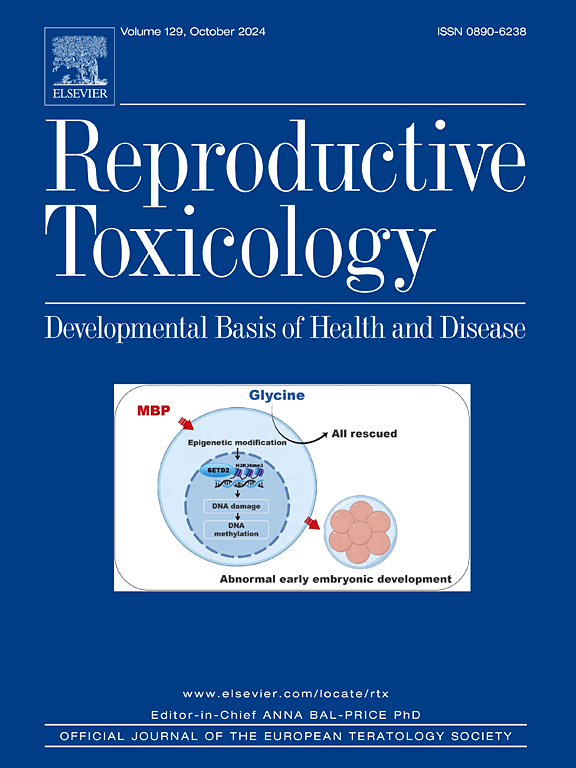Assessing male reproductive toxicity of environmental pollutant di-ethylhexyl phthalate with network toxicology and molecular docking strategy
IF 3.3
4区 医学
Q2 REPRODUCTIVE BIOLOGY
引用次数: 0
Abstract
Environmental pollutants, especially endocrine-disrupting chemicals (EDCs) like di-ethylhexyl phthalate (DEHP), pose serious threats to human health, with DEHP widely implicated in male reproductive toxicity. However, the complex molecular interactions remain unknown. We employed a network toxicology approach combined with molecular docking analysis to identify potential targets and mechanisms of DEHP's toxic effects. Databases such as ChEMBL, STITCH, OMIM, and GeneCards were utilized to gather data, and Cytoscape software was used to construct protein-protein interaction networks. A total of 51 potential targets were identified, with eight core targets, including PTGS2, CASP3, and ESR1, highlighted for their roles in oxidative stress, apoptosis, and hormonal dysregulation. KEGG pathway enrichment analysis revealed significant associations with pathways in cancer, cytokine-mediated signaling, and the hypothalamic-pituitary-gonadal axis. Additionally, gene expression datasets from the Gene Expression Omnibus (GEO) database were analyzed to identify differentially expressed genes overlapped with DEHP targets in testicular diseases. Molecular docking results confirmed strong binding affinities between DEHP and the core target proteins, suggesting a robust interaction mechanism. This study underscores the need for further investigation into DEHP's toxic mechanisms and its combined effects with other environmental pollutants, paving the way for comprehensive risk assessments and the development of targeted intervention strategies.
利用网络毒理学和分子对接策略评估环境污染物邻苯二甲酸二乙基己酯对男性生殖系统的毒性。
环境污染物,尤其是邻苯二甲酸二乙基己酯(DEHP)等干扰内分泌的化学物质(EDC),对人类健康构成严重威胁,其中 DEHP 与男性生殖毒性有广泛联系。然而,复杂的分子相互作用仍是未知数。我们采用了一种结合分子对接分析的网络毒理学方法来确定 DEHP 毒性作用的潜在靶点和机制。我们利用 ChEMBL、STITCH、OMIM 和 GeneCards 等数据库收集数据,并使用 Cytoscape 软件构建蛋白质-蛋白质相互作用网络。共鉴定出51个潜在靶点,其中包括PTGS2、CASP3和ESR1在内的8个核心靶点因其在氧化应激、细胞凋亡和激素失调中的作用而受到重视。KEGG 通路富集分析表明,这些靶标与癌症、细胞因子介导的信号转导和下丘脑-垂体-性腺轴的通路有重要关联。此外,还分析了基因表达总库(GEO)数据库中的基因表达数据集,以确定与睾丸疾病中 DEHP 靶点重叠的差异表达基因。分子对接结果证实,DEHP与核心靶蛋白之间有很强的结合亲和力,这表明DEHP具有强大的相互作用机制。这项研究强调,有必要进一步研究DEHP的毒性机制及其与其他环境污染物的联合效应,从而为全面的风险评估和制定有针对性的干预策略铺平道路。
本文章由计算机程序翻译,如有差异,请以英文原文为准。
求助全文
约1分钟内获得全文
求助全文
来源期刊

Reproductive toxicology
生物-毒理学
CiteScore
6.50
自引率
3.00%
发文量
131
审稿时长
45 days
期刊介绍:
Drawing from a large number of disciplines, Reproductive Toxicology publishes timely, original research on the influence of chemical and physical agents on reproduction. Written by and for obstetricians, pediatricians, embryologists, teratologists, geneticists, toxicologists, andrologists, and others interested in detecting potential reproductive hazards, the journal is a forum for communication among researchers and practitioners. Articles focus on the application of in vitro, animal and clinical research to the practice of clinical medicine.
All aspects of reproduction are within the scope of Reproductive Toxicology, including the formation and maturation of male and female gametes, sexual function, the events surrounding the fusion of gametes and the development of the fertilized ovum, nourishment and transport of the conceptus within the genital tract, implantation, embryogenesis, intrauterine growth, placentation and placental function, parturition, lactation and neonatal survival. Adverse reproductive effects in males will be considered as significant as adverse effects occurring in females. To provide a balanced presentation of approaches, equal emphasis will be given to clinical and animal or in vitro work. Typical end points that will be studied by contributors include infertility, sexual dysfunction, spontaneous abortion, malformations, abnormal histogenesis, stillbirth, intrauterine growth retardation, prematurity, behavioral abnormalities, and perinatal mortality.
 求助内容:
求助内容: 应助结果提醒方式:
应助结果提醒方式:


